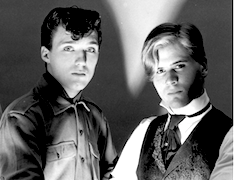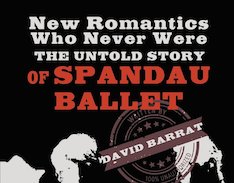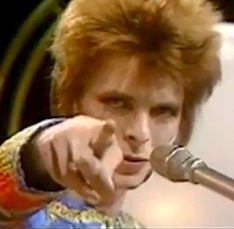
A picture from the archive: sharply styled Spandau Ballet in 1980 playing the dramatically lit Scala cinema concert that eventually brought the record companies scrambling to sign them. (Photograph © by Steve Brown, processed by Shapersofhe80s)
40
YEARS
ON
To celebrate the 40th anniversary of Spandau Ballet’s performance at the trendy Scala cinema on 13 May 1980, their manager Steve Dagger recalls how the event propelled his unsigned band towards the charts and to stardom. Prompted by the waves the band had been making, this – only their fifth live concert – was recorded by London Weekend Television and provided lift-off for the band’s ambitions.
Their first shows were always mounted in secrecy and in novel venues such as the Blitz Club in Covent Garden, which was rapidly becoming the focus for the hippest young people in London who had yet to become known as the New Romantics. The story of those sensational early days is extracted here with Steve’s permission from the full version on the band’s website.

Spandau at the Scala cinema, May 1980: bass-player Martin Kemp surveys the wild dancing by the audience of Blitz Kids captured for TV by 20th Century Box
Steve Dagger writes:
❏ 40 YEARS AGO, on a warm London May evening, at the Scala Cinema, which was then situated on the rather nondescript Tottenham Street, in the heart of what is now Fitzrovia, Spandau Ballet and its previously underground sub-sect of youth culture emerged blinking into the daylight.

Spandau manager Steve Dagger on the road with the band in 1980
Before the show, the crowd, previously not seen en-masse outside of a nightclub, spilled over the pavement clutching drinks from the nearby pub and eying each other up as they arrived, each dressed in their own highly personalised version of the heightened street fashion/plundering of the history of style/Fritz Lang vision of the future that was going to be dubbed “New Romantic” or “Blitz Kids”. All the stylistic cards were being thrown up in the air in a post-modern reset to prepare for a new decade. The event had been advertised by our version of social media, word of mouth, as were all our early shows.
It had the atmosphere of a bizarre red carpet event before a film premiere. There was a TV crew filming and interviewing the arrivals. There were photographers recording the scene. Spandau Ballet were to play live and the performance and the audience were being filmed by LWT for a Janet Street-Porter documentary as part of a TV series called 20th Century Box. The audience was joined by various journalists, photographers and media people, including Radio 1 DJ and TV presenter Peter Powell, numerous record company execs including impresario Bryan Morrison. It was a potent mix which we could have only dreamed of six months earlier before our Spandau Ballet rebirth and was entirely consistent with our title of “The Next Big Thing” and the hottest unsigned band in the country and the new decade.
Since their first performance as Spandau Ballet at the Blitz five months earlier, the band’s career trajectory had been such that it seemed to have been fired out of some powerful pop culture cannon. A lot had happened! We had exploded from a standing start like Usain Bolt.

Spandau at the Scala: Blitz Kids arrive in high style to watch the band perform in an auditorium for the first time, captured by 20th Century Box
At that first Blitz show in December 1979, Chris Blackwell, legendary founder and owner of Island Records – the world’s coolest record company – had approached me offering to sign the band “on the spot”. It was a hugely seductive and exciting opportunity but there was a deal to be done.
Accompanied by our newly appointed lawyer, Brian Carr, the band and I went to meet Chris at the Island HQ in London, a large relaxed converted villa on St Peter’s Square in Hammersmith. Posters and gold and platinum discs of Bob Marley, Roxy Music, Stevie Winwood and Grace Jones greeted us. Chris showed us around. He was charming and smart. It all seemed so right. For a while. He introduced us to Nick Stewart, an A&R man who was to be our point person. He had the demeanour of an army officer. I think he was a friend of Chris’s from public school. He listened to our ideas about the band – it seemed very hard to explain the band’s ethos to him. Chris was not a UK resident at the time and had a limited time in the country each year. We would be dealing with Nick day-to-day. Not good. Then they showed us the terms of the deal they were proposing.
We retired for lunch at a local Chinese restaurant with Brian to consider it. I suppose it was an OK deal for a new band, but both Brian and I thought we could do better. We went back to Island HQ after lunch and after a short discussion about the terms, on a pre-arranged cue from Brian, we turned down the deal and ended the meeting abruptly and walked out. It was spectacular! Their jaws dropped. It showed huge confidence on our part. It was a bold effective tactic. It did mean however that we were very shortly in Hammersmith Broadway, on foot, without a record contract.
Although there was a vigorous discussion about the wisdom of this move with the band and myself later that evening, so powerful was our newly acquired self-confidence everyone soon settled down. Shortly afterward Chis left town for Paris or Jamaica and although we kept in contact and he maintained interest, we didn’t sign to them. We were soon to be distracted by other suitors and opportunities.

Spandau at the Scala: the moment the band began playing, the audience filled the aisles with their dancing, captured by 20th Century Box
Meanwhile, our progress continued apace. Days after the visit to Island the band played their second show as Spandau Ballet at Mayhem Studios Battersea at a multi-media event party organised by a number of our friends and now collaborators from the Blitz. It was in effect the first Warehouse Party Brand that would morph eventually into the ubiquitous rave format. There were art-house and porn films projected onto the ceiling, DJs, alcohol, drugs, Spandau Ballet and hundreds and hundreds of people crammed into a relatively small space. The combined word of mouth powers of Chris Sullivan, Graham Ball, Robert Elms and Graham Smith reached every hip club person in London. Blitz Kids, Soul Boys and Rockabillies. All soon to merge together into “Club Culture”. It was rammed.
Hundreds couldn’t get in. It was bloody chaos. The band performed and were well received, but most people that were there couldn’t see them, it was so crowded. But that wasn’t the point. The value to us was that we were for the second time in as many weeks performing at the epicentre of hipness in the new London. Even if you hadn’t seen the band or even couldn’t get in, everyone knew that Spandau Ballet had played there. It was most certainly an event.
On New Year’s Eve as the 80s started, I remember feeling utterly satisfied with the band’s progress in the last month. We were right in the sweet spot of being the coolest band in the hippest scene in London. The decade seemed to be opening up before us. Great, but what next? . . . / Continued at Spandauballet.com

Spandau at the Scala: their audience of dancing Blitz Kids confirmed their status as the hottest unsigned band in the land, captured by 20th Century Box
ELSEWHERE AT SHAPERS OF THE 80S:
➢ A selective timeline for the unprecedented rise and rise
of Spandau Ballet
➢ Spooky or what? The amazing revelation that two bands went by the name of Spandau Ballet
➢ Private worlds of the new young setting the town ablaze
➢ Just don’t call us New Romantics, say the stars of the Blitz
FRONT PAGE





























